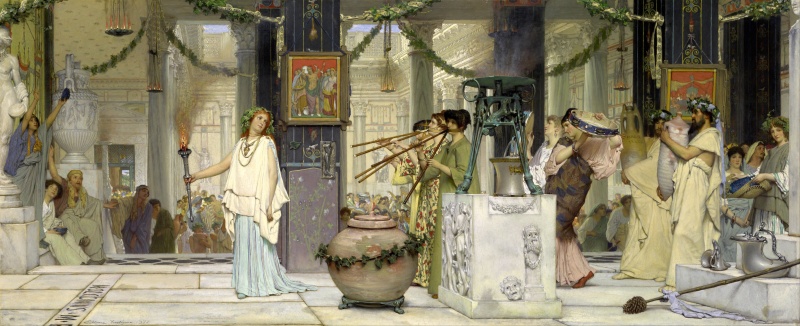Well, sort of.
Remember the time I was scratching my nonexistent beard over which calendar to declare “official” for our feast-days? Well, just before the New Year, we decided that it would be best to go dual. This means that the festivals will be reckoned according to both the civic (Gregorian) calendar and a lunar one.
Names of the months
- Civic months are to remain the same in name and sequence as the Gregorian calendar (ie. January is the 1st month, February is the 2nd, and so on); however, there is some debate whether it would be better to rename these months as “First Month”, “Second Month” (and so on), so as not to affect the ritual “moods” of the months (and by this we mean not necessarily seeing March as a martial month).
- The calends of every civic month are to be celebrated using ritus romanus at home, and between 6:00 to 9:00 in the morning; the household gods are especially worshipped during this time.
- It has not yet been decided if the nones and ides are to be celebrated as religiously as the calends.
- Most of the lunar months will retain either their Makedonian or Athenian names; others will take new names to reflect the major cultic activity within that month.
- New moons (noumênia), full moons (dikhomênia), and other lunar-reckoned festivals are to be celebrated using ritus graecus, outdoors if possible, and between 6:00 to 9:00 in the evening; the pan-Hellenic gods are especially worshipped during these times.
- The final names have yet to be decided.
Date of the New Year
- There are two dates for the New Year: a Roman one and a Graeco-Egyptian one (since, we’re basically a Romano-Hellenistic tradition centred around ancient Alexandria): the Roman one occurs on the calends of January and the Hellenistic one is… yet to be finalised.
- Just recently, we changed the Hellenistic New Year from the Makedonian reckoning to — wait for it — the Chinese one (beginning on the second noumênia after the winter solstice). It has been a long-standing practice to observe both civic and lunar new years in the mestizo (multicultural) cities of the Philippines, so we’ve decided to officially incorporate this into our Hellenistic cycle (check out the previous article for more).
- Thus, lunar months are to start from the “Chinese New Year” or the beginning of Anthestêriôn.
- However, there is an alternative New Year which starts from the first new moon after the summer solstice (on the same date as the Athenian New Year) which is when the dry season ends and the monsoon winds return to our islands (this is around the same time rice-planting resumes).
- Wep Ronpet, instead of being another New Year, will be transformed into the “Festival of the Rising of the Dog-star“. Year-end customs, such as the breaking of pots and the cutting of
Apophis, will be absorbed into the civic calendar’s New Year.
Seasons
- Seasons will, of course, follow those of our city, although, there is an interesting reversal between our tropical climate and that of the fatherland in the Mediterranean.
- The year is divided into 3 primary seasons: the first half is hot-wet whilst the second half is divided into cold-dry and hot-dry.
- Most of the seasonal or agrarian festivals will follow local seasons, not those of the Mediterranean. As such, “harvest-time” generally refers to the rice harvests that happen around October to March, unless specified otherwise.
- Naturally, this affects the mythology of the year:
- The Maiden’s descent into the Underworld happens in the short season of drought between the months of late March to late May, which, coincidentally, is the time of flowering in the Mediterranean. Does she leave the islands to make way for the West? Who knows.
- The hot-dry season is also caused by the exile of the Thunderer from his halls; he is annually defeated by Drought who usurps the throne; the Thunderer returns around early June or July, defeating Drought with a vengeance, around the same time the hot-dry season begins around the Mediterranean.
- Propitiatory rites are done for the Thunderer during the onset of the monsoon season (similar to ceremonies done for Zeus around Maimakteriôn and Poseideôn in ancient Greece).
- Some harvest festivals, however, will be Mediterranean, such as the grape or olive harvest.
Festival dates
- Hellenic, Jewish, Qadish, and Hindu festivals follow lunar reckoning whilst Roman festivals follow the Gregorian calendar.
- Egyptian festivals follow Neos Alexandria’s Egyptian calendar (based on the actual rising of Sirius at Alexandria, Egypt).
So, there it is, folks. Whilst far from finished, this new calendric system stands until further improved. May it be so!
Again, suggestions are welcome if you have any.







![IMG_20131028_134148[1]](https://undertwotrees.files.wordpress.com/2013/10/img_20131028_1341481.jpg?w=480&h=480)
![IMG_20131028_134056[1]](https://undertwotrees.files.wordpress.com/2013/10/img_20131028_1340561.jpg?w=480&h=480)
You must be logged in to post a comment.